This time of year, my family enjoys taking a weekend snowshoeing and cross-country skiing outing in the Idaho mountains to the north of our home. There is much to recommend this adventure: breathtaking scenery, great exercise and the peace of gliding amongst ponderosa pines at dusk.
However, wildlife sightings can be particularly hard to come by. With deep snow and frigid temperatures, the Rocky Mountains are not particularly hospitable in winter. Many species migrate to lower elevations or warmer climes. Others hibernate or become inactive. The species that do stick around are often difficult to spot.
A notable exception is the pileated woodpecker, one of our most frequently spotted species on these outings. Pileated woodpeckers are big, striking and entertaining to watch. With a range covering many habitats across the United States and Canada, you may be able to make your own observations near your home.
Pileated woodpeckers are notably elusive birds. Despite their size, in the spring I often only see their distinctive wing flaps as they fly away from me. In the winter, though, I’ve found that you can often get quite close and observe them undisturbed.
What you will notice first, of course, is their legendary wood pecking. Their large, strong bill serves as a powerful chisel on dead trees. The pileated woodpecker will eat a variety of foods, including seeds and a number of insects, but carpenter ants make up their primary diet. (The Cornell Lab of Ornithology reports that the diets of some studied pileated woodpeckers are made up of 98 percent carpenter ants).
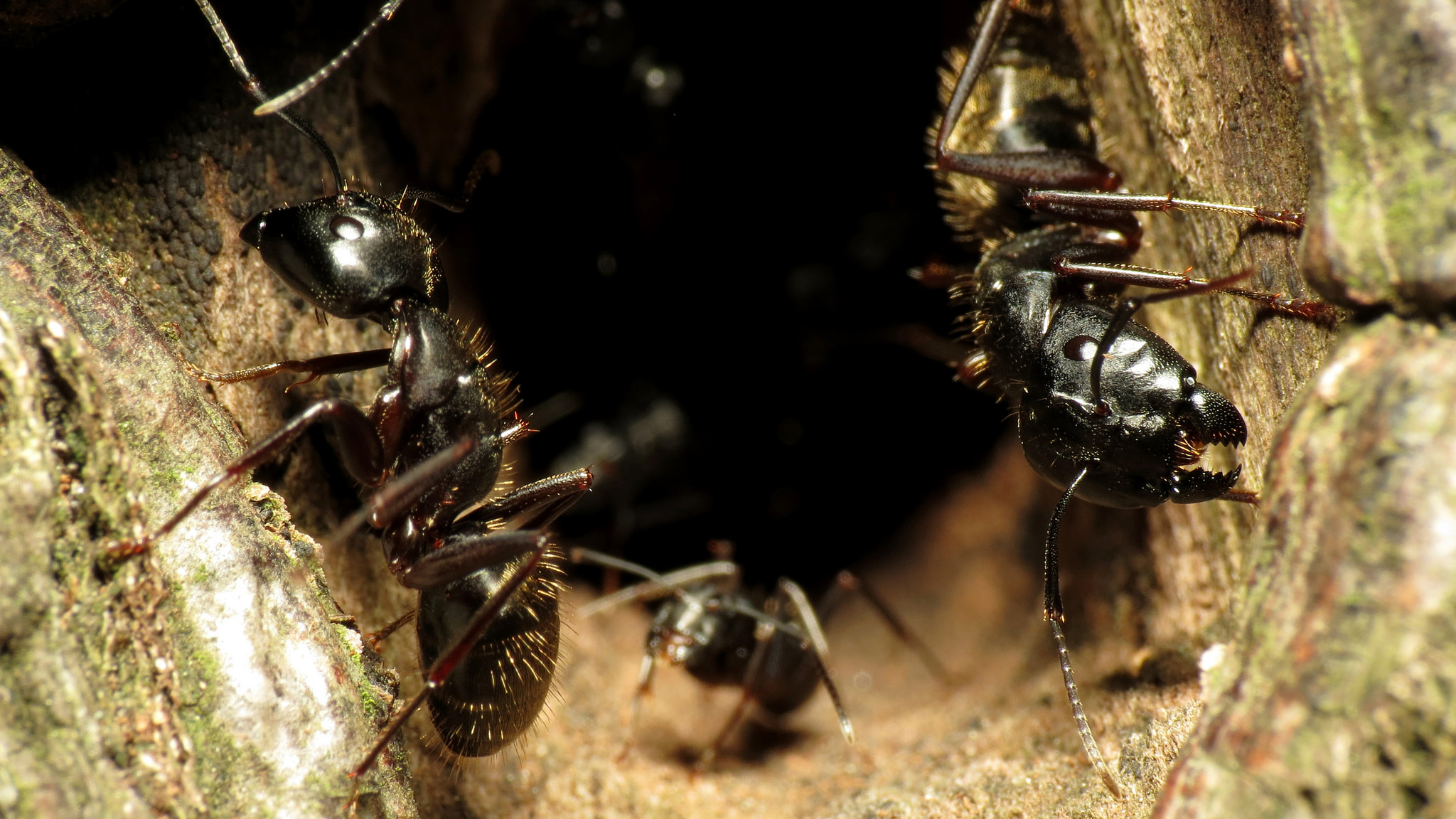
The woodpeckers go to great lengths to extract these ants. They pound out large, square holes in soft, dead wood. According to the Cornell, they use their barbed tongues to extract their prey from deep in the hole. Dead trees with abundant ant populations are foraged repeatedly by the woodpeckers. You can often see a tree full of holes from a distance (especially in winter) and piles of woodchips will pile up on the snow.
Stake out such a tree and you’re almost certain to see a pileated.
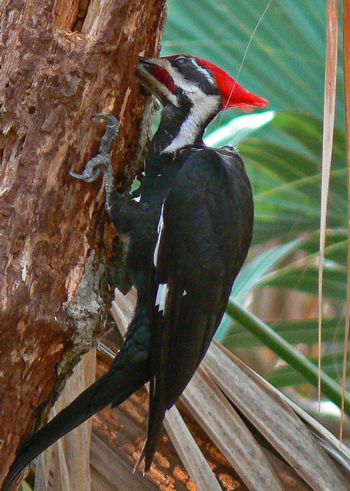
I love how deep snow muffles sound in the forest. But a woodpecker’s rat-tat-tatting still carries. The pileated woodpecker also has a very distinctive call, one that sounds like it would be more at home in a Hollywood movie set in the Amazon than in the local woodlot. In late winter (and other times of year), the male will often “drum” on a tree to mark territory.
Why are pileated woodpeckers so noticeable on a Rocky Mountain winter day? It’s quite simple: they don’t migrate. The species is highly territorial and a monogamous pair inhabits and defends a territory year round. When a member of the pair dies, a new woodpecker can move in and become mates with the surviving member.
The pair’s territory can be 150 to 200 acres. You may find, as I do, that you find pileated woodpeckers in basically the same spots each year. If a dead tree is still standing, you will probably find the same pair foraging there.
Ornithologist Joe Smith wrote previously on Cool Green Science how some bird species huddle together in large masses to stay warm on a cold winter’s night. (There is a report of more than 100 pygmy nuthatches piling into a hole in a dead pine tree on a particularly cold night). Pileated woodpeckers are the opposite: in the winter, each woodpecker excavates its own hole and roosts by itself. The male woodpecker often uses the same hole used for nesting; the young birds have already dispersed by winter.
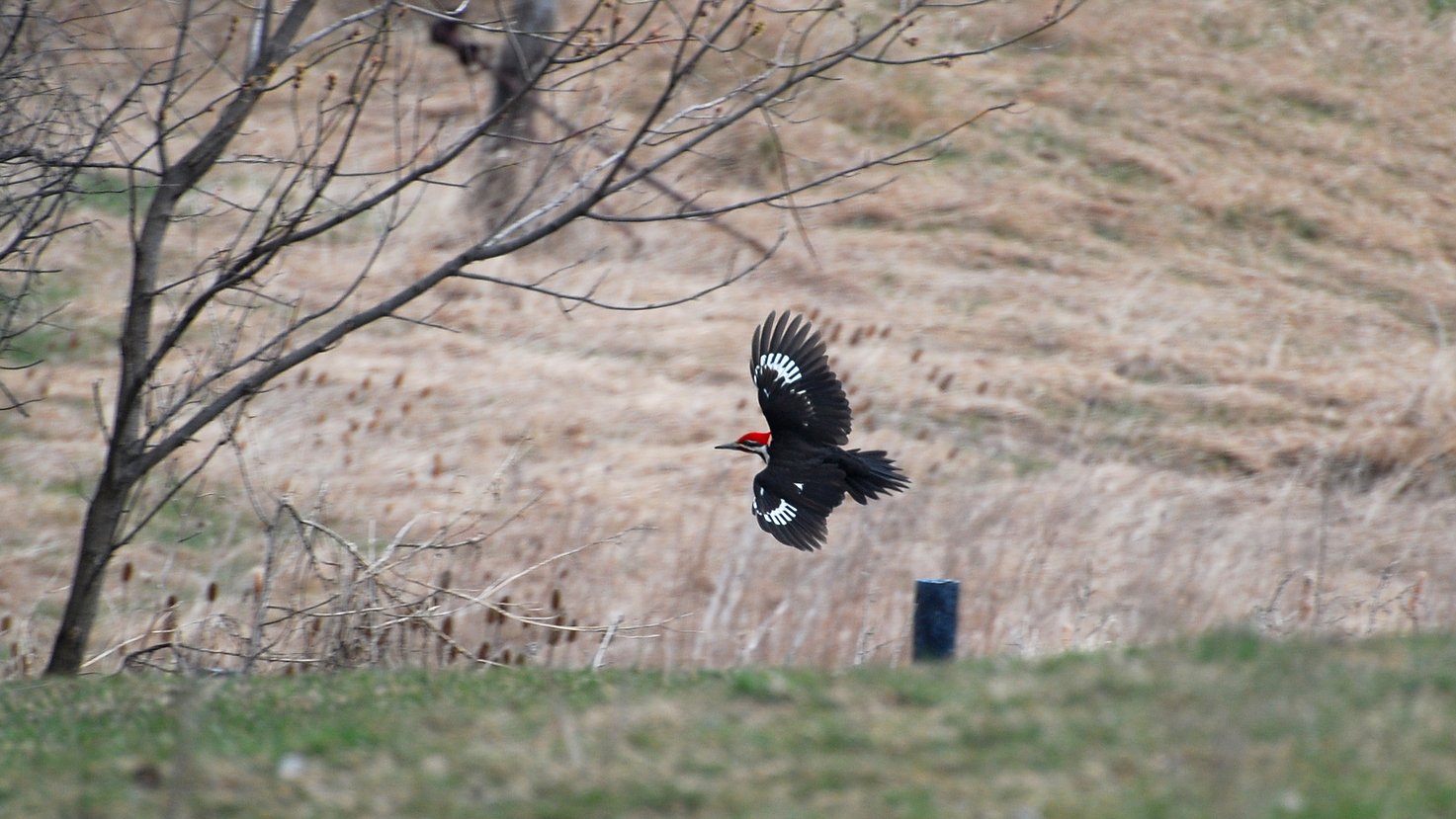
The pileated woodpecker is an important species in many different forest ecosystems. Their extensive holes become homes and shelter for a variety of species, from wood ducks to American martens. Their loud foraging attracts other birds to share in the bounty.
Pileated woodpeckers have actually increased in population since 1966, according to Cornell. The biggest thing we can do to ensure their continued prosperity is this: keep some dead trees in the forest.
Dead trees are sometimes considered unsightly or dangerous, but they’re vital to a variety of wildlife. Pileated woodpeckers forage on standing dead trees, fallen trees and stumps. Private landowners, preserve managers and timber companies can all leave a few dead trees for the birds.
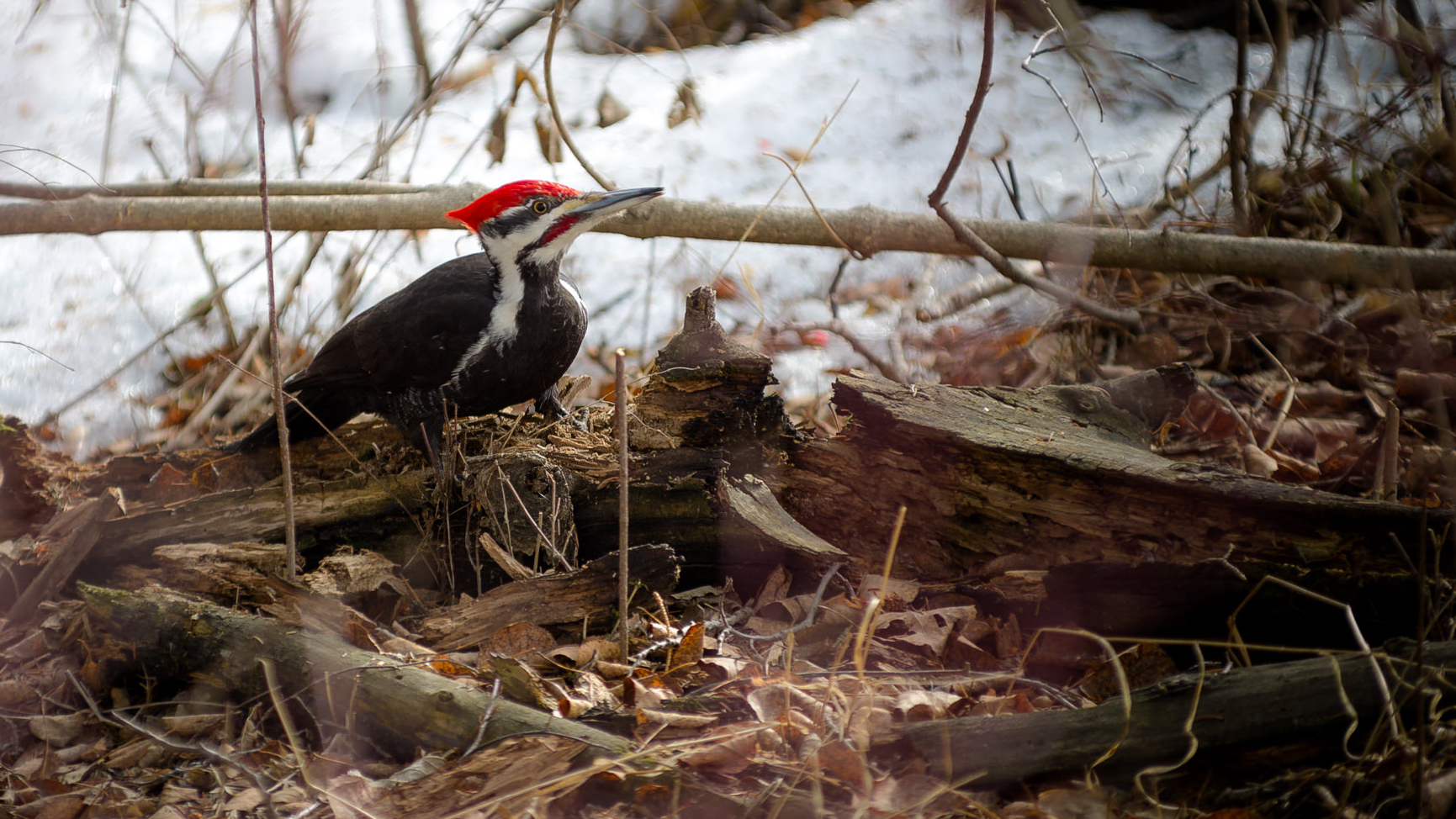
Dead trees were part of The Nature Conservancy’s forest conservation planning in North Idaho, and I saw these dead trees even on industrial timber land. And without fail, those trees would be pocked with holes from woodpeckers.
Pileated woodpeckers are found in a variety of forest habitats in North America, not just the ponderosa pine ecosystem of the Rockies. Get out there, listen and observe. The pileated woodpecker is elusive and spectacular, but the great news is it is still very common in forests and woodlots.
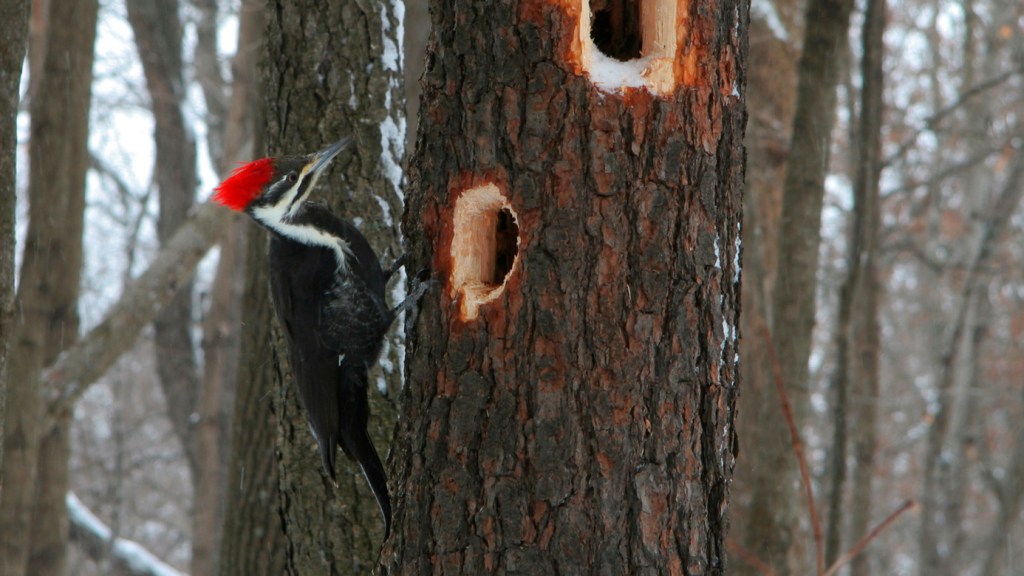



Last summer a colony of feral honey bees moved into an old ash tree on our cottage property. We enjoyed watching them come and go throughout the season and when we locked up in the fall, wondered if they’d survive the winter. However, when we returned this spring, the bees were gone, and beside their entry point in the tree, was a large, soccer ball sized hole. There are other holes in the tree as well, oval in shape, and not quite as large. We’re guessing the hive fell prey to pileated woodpeckers?
Hi Frances, Thank you for the question! It’s possible. One way to find out would be to submit images of the trees with the holes to your area museum or university or to iNaturalist and see if anyone is able to ID the species based on the size and shape of the holes.
I live in mid Michigan and have 40 acres of woods behind my house. The Pileated Woodpecker made a large rectangular hole about 60 feet up in a live poplar tree off my backyard. This was the end of February. A month later, I saw the male and female there, grooming each other and using nest. I have been following their activity, waiting for signs of feeding young. I would see the male peek out of the hole usually every day. Yesterday morning, April 27, I saw both birds and then was astounded to see a grey squirrel go up their tree. It was dive bombed, but came back. I saw it enter the nest three times, and they did not defend their nest. The last time, the squirrel had a mouth full of leaves. The female woodpecker sat on a branch nearby for over a half hour, mourning the loss? I think the male had flown off. This morning, I saw the squirrel bring another mouthful of leaves to it’s new nest. Was I mistaken? Was this only a feeding site? I love birds, especially the pileated woodpecker, and have been tracking it’s existence for over 15 years in my area. I was so excited to maybe see young fledge the nest before the trees leafed out. Any thoughts on this hostile takeover will be appreciated. Sad bird watcher.
I am going to Lake Nockamixon in the middle off May to look for the Pileated. I am from California and for 3 years have had no luck spotting one. Can you recommend a couple of trails or spots were they could be found at this time of year. It would be greatly appreciated.
thank you
Jack
Saw a green pleated woodpecker in woods of Alabama
On Tennessee River. Emerald green with crest on head
Have a pair in St. Albert, Alberta Canada they bring their babies into my yard and last year I saw them mating on the fence. Always enjoy their visits.
I have had the delight since we moved near Parry Sound Ontario of frequently watching a pair of pileated woodpeckers. However my observations have shown me that it is certainly not just dead trees upon which these, as well as the downy and hairy also in the area, forage. Indeed the first photo in this article, taken in Wisconsin, appears to be on a live tree. And the chips certainly do fly!
We have pileated woodpeckers (along with downy, hairy, and red-bellied woodpeckers) at our cabin in the West Virginia Panhandle. All the varieties have been enjoying the suet based food we leave out for them. We have even had the pileateds land on our deck’s railing in order to visit our feeder! Much as we lovely our red-headed friends, they have caused extensive damage to the trees in our area. I was told that they only create their holes in dead/dying trees, but the number of trees they have damaged that appear to be healthy is a major concern. I would appreciate knowing if indeed all these trees are infected or in fact, the pileateds do go after live trees. Any ideas to discourage our friends from the healthy trees?
Hi Mary Jane, Here is an article from The Spruce on more reasons why woodpeckers peck and some things that you can do to deter them without harming them: https://www.thespruce.com/stop-woodpecker-damage-386450 Thank you for the question!
They are even rarer here in Northwest IN I seen them a few times and seen the trees they dug into
For the past 5+ years I have lived in The Texas Hill Country west of Austin after having retired and moved from Houston. I thought I read where the Pialeted Woodpecker was thought to be extinct or rarely seen. Could it have been referring to the East Texas piney woods area on our eastern border? Or, am I confusing it with another variety of woodpecker? I would like to know. Fritz
Hi Fritz, You are likely thinking of the similar ivory-billed woodpecker, which could be extinct, though there is some hope that it is hanging on. Most reports of ivory-billed woodpeckers are the result of misidentification of pileated woodpeckers. Ivory-billed https://www.allaboutbirds.org/guide/Ivory-billed_Woodpecker/id Pileated: https://www.allaboutbirds.org/guide/Ivory-billed_Woodpecker/species-compare/60408671
I love this!
received my first article and enjoyed very much. We have recently moved the northern Maine(downeast) and have taken up bird watching again. we have seen hairy woodpeckers in our backyard taking advantage of the birdfeeder. looking forward to more articles.
We live in the eastern panhandle
Of WV in a location with hundreds of acres of woodland along the Potomac River . We have the pleasure to see and hear them on a regular basis year round . They are spectacular birds to have show up on the suit cakes during the winter months . I’ve been privy to seeing a young male , with his red mustache and a young female feeding there together at the same time with a larger more mature male watching
them as he hung on the same tree
just above them both .. what a beautiful Sight ! A parent keeping
an eye on his young possibly ?
What a great article about my favorite bird!
My friend and I were walking this weekend in Penninsula State Park in Door County WI and saw one. I noticed the pile of chips first, then all the holes in the tree and then the Pileated woodpecker flying to a nearby tree. We watched him for a while. It was great to see and hear him.
We have these woodpeckers here is Lake Texoma. They are huge and quite noisy,